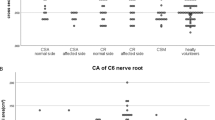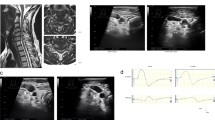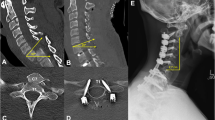Abstract
Study design
Observational cohort study
Objectives
To investigate preoperative factors that predict fair outcomes following surgery in patients with proximal cervical spondylotic amyotrophy (CSA) using electrophysiological and neurological findings.
Setting
Yamaguchi University
Methods
54 patients with proximal CSA who underwent surgical treatment of the cervical spine were enrolled. Erb-point stimulated compound muscle action potentials (CMAP) were recorded from the deltoid and biceps brachii muscles. We computed the ratio of affected to normal side CMAP amplitudes in two muscles (deltoid and biceps brachii) and regarded the mean ratio (CMAP-R) as representing the severity of neural involvement. Pre- and postoperative strengths of the most atrophic muscles were evaluated using manual muscle testing. Improvements in strength were classified as excellent (5 grades recovered), good (more than one grade recovered), fair (no improvement), or poor (worsened).
Results
Surgical outcomes were excellent in 26 patients, good in five, fair in 16, poor in seven. Patients with fair outcomes had lower CMAP-R than those patients with excellent and good outcomes [P = 0.0099, odds ratio = 0.89 (95% confidence interval, 0.81−0.97; for a change of 10%)]. Eight patients (15%) had a C5 palsy.
Conclusions
CMAP-R could be used as a reliable predictive factor related to a fair surgical outcome. We must pay attention to the incidence of C5 palsy after surgery.
Similar content being viewed by others
Log in or create a free account to read this content
Gain free access to this article, as well as selected content from this journal and more on nature.com
or
Data availability
The datasets generated and /or analyzed during the current study are available from the corresponding author on reasonable request.
References
Sobue I, Kato H, Yanagi T. Clinical characteristics and classification of cervical spondylotic amyotrophy. Rinsho Shinkeigaku. 1975;10:999–1006.
Jiang SD, Jiang LS, Dai LY. Cervical spondylotic amyotrophy. Eur Spine J. 2011;20:351–7.
Imajo Y, Kato Y, Kanchiku T, Suzuki H, Yoshida Y, Funaba M, et al. Prediction of surgical outcome for proximal-type cervical spondylotic amyotrophy novel mode of assessment using compound action potentials of deltoid and biceps brachii and central motor conduction time. Spine. 2012;37:E1444–E1449.
De Carvalho M, Dengler R, Eisen A, England JD, Kaji R, Kimura J, et al. Electrodiagnostic criteria for diagnosis of ALS. Clin Neurophysiol. 2008;119:497–503.
Barker AT, Jalinous R, Freeston IL, Jarratt JA. Clinical evaluation of conduction time measurements in central motor pathways using magnetic stimulation of the human brain. Lancet. 1986;7:1325–6.
Ranvnborg M, Blinkenberg M, Dahl K. Standardization of facilitation of compound muscle action potentials evoked by magnetic stimulation of the cortex. Results in healthy volunteers and in patients with multiple sclerosis. Electroencephalogr Clin Neurophysiol. 1991;81:195–201.
Kaneko K, Taguchi T, Morita H, Yonemura H, Fujimoto H, Kawai S. Mechanism of prolonged central motor conduction time in compressive cervical myelopathy. Clin Neurophysiol. 2001;112:1035–40.
Tani T, Kishimoto H, Tsuboya H, Kimura J. Electrophysiologic assessment of shoulder girdle weakness in patients with cervical spondylosis: prognostic value of supraclavicular stimulation. J Clin Neuromuscul Dis. 2002;4:11–18.
Funaba M, Kanchiku T, Imajo Y, Suzuki H, Yoshida Y, Taguchi T. Preoperative diagnosis of the responsible level in CCM using CMAPs: comparison with SCEPs. Spinal cord. 2014;52:191–6.
Iwanami T, Sonoo M, Hatanaka Y, Hokkoku K, Oishi C, Shimizu T. Decremental responses to repetitive nerve stimulation (RNS) in motor neuron disease. Clin Neurophysiol. 2011;122:2530–6.
Zheng C, Jin X, Zhu Y, Lu F, Jiang J, Xia X. Repetitive nerve stimulation as a diagnostic aid for distinguishing cervical spondylotic amyotrophy from amyotrophic lateral sclerosis. Eur Spine J. 2017;26:1929–36.
Fujiwara Y, Tanaka N, Fujimoto Y, Nakanishi K, Kamei N, Ochi M. Surgical outcome of posterior decompression for cervical spondylosis with unilateral upper extremity amyotrophy. Spine. 2006;31:E728–E732.
Tauchi R, Imagama S, Inoh H, Yukawa Y, Kanemura T, Sato K, et al. Risk factors for a poor outcome following surgical treatment of cervical spondylotic amyotrophy: a multicenter study. Eur Spine J. 2013;22:156–61.
Tauchi R, Imagama S, Inoh H, Yukawa Y, Kanemura T, Sato K, et al. Appropriate timing of surgical intervention for the proximal type of cervical spondylotic amyotrophy. Eur J Orthop Surg Traumatol. 2015;25(Suppl 1):S107–S113.
Uchida K, Nakajima H, Yayama T, Sato R, Kobayashi S, Kokubo Y, et al. Anterior and posterior decompressive surgery for progressive amyotrophy associated with cervical spondylosis: a retrospective study of 51 patients. J Neurosurg Spine. 2009;11:330–7.
Nakanishi K, Tanaka N, Sasaki H, Kamei N, Hamasaki T, Yamada K, et al. Assessment of central motor conduction time in the diagnosis of compressive thoracic myelopathy. Spine. 2010;35:E1593–E1598.
Claus D. Central motor conduction: method and normal results. Muscle Nerve. 1990;13:1125–32.
Imajo Y, Kanchiku T, Suzuki H, Yoshida Y, Funaba M, Nishida N, et al. Effects of differences in age and body height on normal values of central motor conduction time determined by F-waves. J Spinal Cord Med. 2017;40:181–7.
Sakaura H, Hosono N, Mukai Y, Ishii T, Yoshikawa H. C5 palsy after decompression surgery for cervical myelopathy. Spine. 2003;28:2447–51.
Kaneko K, Hashiguchi A, Kato Y, Kojima T, Imajo Y, Taguchi T. Investigation of motor dominant C5 paralysis after laminoplasty from the results of evoked spinal cord responses. J Spinal Disord Tech. 2006;19:358–61.
Imagama S, Matsuyama Y, Yukawa Y, Kawakami N, Kamiya M, Kanemura T, et al. C5 palsy after cervical laminoplasty: a multicenter study. J Bone Jt Surg. 2010;92:393–400.
Acknowledgements
The authors acknowledge Prof. Kiyoshi Ichihara, Department of Clinical Laboratory Sciences, Faculty of Health Sciences, Yamaguchi University Graduate School of Medicine, who performed all of the statistical analysis and supported paper preparation.
Author information
Authors and Affiliations
Contributions
YI was responsible for designing and conducting the search. NN, MF, HS, and TS were responsible for extracting and analyzing data, interpreting results.
Corresponding author
Ethics declarations
Conflict of interest
The authors declare that they have no conflict of interest.
Ethical approval
We certify that all applicable institutional regulations concerning the ethical use of human volunteers were followed during the course of this research.
Additional information
Publisher’s note Springer Nature remains neutral with regard to jurisdictional claims in published maps and institutional affiliations.
Rights and permissions
About this article
Cite this article
Imajo, Y., Nishida, N., Funaba, M. et al. Preoperative factors that predict fair outcomes following surgery in patients with proximal cervical spondylotic amyotrophy. A retrospective study. Spinal Cord 58, 348–355 (2020). https://doi.org/10.1038/s41393-019-0365-2
Received:
Revised:
Accepted:
Published:
Issue date:
DOI: https://doi.org/10.1038/s41393-019-0365-2



